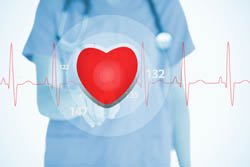Effects of low-dose radiation on the heart
Until recently, the damage brought on by radiation in humans was perceived to be related purely to cancer development. However, recent evidence has come to challenge this dogma, showing radiation-induced mortality from cardiovascular and cerebrovascular diseases. These epidemiological data demand that radiobiological experiments be carried out in order to reassess and define radiation exposure risks. Especially when it comes to dose definition, experimental evidence is needed to evaluate the impact of a particular radiation dose on function and pathology. The EU-funded project 'The mechanisms of cardiovascular risks after low radiation doses' (CARDIORISK) aimed to assess the impact of radiation exposure on microcirculation of the heart and on atherosclerotic lesions in arteries. For this purpose, partners investigated molecular, pro-inflammatory and pro-thrombotic changes as well as alterations of cardiac function, including myocardial perfusion and cardiac cell integrity. Detailed information can be found online(opens in new window). As experimental models, researchers used control mice or mice deficient in Apoliprotein E, which are prone to the development of atherosclerosis. Following specific irradiation of the heart or arteries, they monitored molecular and cellular responses at different times and associated them with histopathological and functional changes of the cardiac microvasculature and arteries. To study cardiovascular changes in vivo, optical coherence tomography (OCT) was implemented for vessel imaging and single photon emission computed tomography (SPECT-CT) for the heart. Given the paramount importance of angiogenesis to cardiac repair, the consortium developed in vitro assays to evaluate the effect of radiation on heart neovascularisation. These assays revealed that the angiogenic capacity of endothelial cells was inhibited even at low doses. Examination of inflammatory responses and thrombotic changes in irradiated hearts alongside the analysis of inflammation-related gene expression revealed that the microvascular radiation damage induced in small capillaries was independent of pro-inflammatory events. In contrast, the impact of high-radiation doses on large arteries was triggered by increased inflammation. Although the findings of the CARDIORISK project suggest that low-dose radiation does not per se induce atherosclerotic changes, it may indirectly affect the stress response of the heart. As a result, when considering radiation protection — especially in radiation oncology — different doses should be estimated for the myocardium and separately for the coronary arteries.







